(この記事の翻訳はDeepL翻訳を使っています。おかしな翻訳もあると思いますが、みなさんの脳内で変換してお読みください。)
翻訳元:
https://spielverlagerung.com/2020/04/01/the-evolution-of-counterattacking/
As we move forward through the years football continues to evolve. The developments are not often massive evolutions such as Sacchi’s zonal congestion from the 80s or Michels’ and Cruyff’s total football from the 70s, but
most frequently minor positional or role adjustments within the different phases of the game. Every goal scored for your team and every goal conceded that is prevented for your team has high
value – and as analytics continue to grow within our sport, we are seeing its impact on football’s phases little by little.
Set pieces such as corners, freekicks, goal-kicks, and even throw-ins are being analyzed to the finest of details both qualitatively and quantitatively. It can be observed in the latest
world cup that teams are beginning to defend on average more compact as a block, “Teams at this
World Cup were more compact in defence, with a tournament average of 26m between a side’s deepest defender and highest attacker out of possession. The amount of space available has been dramatically reduced, making it challenging to find openings.” – 2018
FIFA World Cup Technical Report
A higher number of teams are implementing aspects of a more modern possession game and taking care of the details in the defensive transition than before – with clear ideas on how and when to counter-press and set up their rest-defense.
Many goals have always resulted from the offensive transition moments through the
history of football, but we are beginning to see an evolution even in that phase of play to make it as efficient and dangerous as possible. With teams improving overall in their defending, the counterattacks need to be even faster and more precise than in the past. In this tactical theory article, we will take a look at how counterattacks have developed over the years to where we are now with leaders such as Jurgen Klopp’s Liverpool FC as the modern example.
我々が年を追うごとに、サッカーは進化し続けている。その進化は、80年代のサッキの帯状混雑や70年代のミッシェルとクリュイフのトータルフットボールのような大規模な進化ではなく、ゲームのさまざまな局面での小さなポジションや役割の調整がほとんどです。チームのために得点したすべてのゴールと、チームのために防がれたすべてのゴールには高い価値があります。
コーナー、フリーキック、ゴールキック、さらにはスローインなどのセットピースは、質的にも量的にも細部まで分析されています。最新のワールドカップでは、「今回のワールドカップのチームはディフェンスがよりコンパクトになってきており、大会平均ではサイドの最も深い位置にいるディフェンダーと最も高い位置にいるアタッカーとの間に26mのスペースを確保していた」と、ブロックとしての守備がよりコンパクトになってきていることが観察できます。利用可能なスペースの量は劇的に減少しており、オープンスペースを見つけることが難しくなっている」。- 2018 FIFAワールドカップ テクニカルレポート
より現代的なポゼッションゲームの側面を取り入れ、ディフェンスのトランジションの細部にまで気を配っているチームが以前よりも増えている。
サッカーの歴史の中で、多くのゴールは常に攻撃的なトランジションの瞬間から生まれてきたが、私たちはこの局面でも、可能な限り効率的で危険なプレーをするための進化を見始めている。チームの守備が全体的に向上している今、カウンターアタックはこれまで以上にスピードと正確さが求められています。この戦術論の記事では、ユルゲン・クロップのリバプールFCのような指導者を現代の例として、カウンターアタックがどのように発展してきたかを見ていきたいと思います。
The Counterattack
カウンターアタック
To put it simply, a counterattack is when a team attacks immediately after regaining the ball from defending the opponent’s attack. As the opponent team loses possession of the ball, they are moving from a structure that allows them to better attack the defense into a structure that allows them to better defend the attack. In this short period of time, the team which is winning the ball can attack the opponent’s transitional organization before they get back in position to protect themselves more effectively.
簡単に言うと、カウンターアタックとは、相手の攻撃を守備からボールを奪い返した直後に、チームが攻撃することです。相手チームがボールを奪い返すと、守備をより良く攻撃できる構造から、攻撃をより良く守れる構造へと移行していきます。この短い時間の中で、ボールを獲得しているチームは、より効果的な守備に戻る前に、相手のトランジション組織を攻撃することができます。
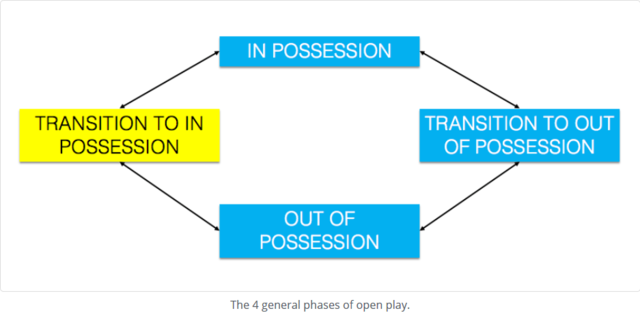
オープンプレイの一般的な4つの局面。
The same principles of attack apply as when you are in a positional organization, but it is typically done faster and with different structures between the teams. Players seek the immediate ball in behind the defense to a free striker or winger, a pass directly into a free attacking midfielder
between the lines, or passes into the feet of the marked forward(s) to create a lay off pass to a forward-running teammate just as they normally would.
Players with the ball run forward until there is pressure or if there is a teammate already in a better position and then pass the ball or dribble past the opponent, players off the ball look to get open for passes toward the opponent goal and reduce the cover the opponents have through spacing. It is all simply done in the context of a transition between attack and defense. In transitions, a team will normally look to fill the center, right and left channels with runners to provide passing options and reduce cover – similar to the concept of “filling the lanes” in offensive transition in basketball.
攻撃の原則は、ポジション別の組織にいるときと同じであるが、それは通常、チーム間で異なる構造で、より速く行われる。プレーヤーは、ディフェンスの後ろにいるフリーのストライカーやウインカーにすぐにボールを求めたり、ラインの間にいるフリーの攻撃的なミッドフィルダーに直接パスを出したり、マークされたフォワードの足元にパスを出して、通常と同じように前に走っているチームメイトにレイオフパスを出したりする。
ボールを持っているプレーヤーは、プレッシャーがかかるまで、あるいはすでにより良い位置にいるチームメイトがいる場合には、ボールをパスするか、ドリブルで相手を追い越し、ボールを持っていないプレーヤーは、相手のゴールに向かってパスを出すためにオープンになり、相手が持っているカバーを減らすために間隔を空けようとする。これはすべて、攻撃とディフェンスの間のトランジションの文脈で行われています。トランジションでは、通常、チームは中央、右、左のチャンネルをランナーで埋め、パスのオプションを提供し、カバーを減らすことに目を向けます - バスケットボールのオフェンシブトランジションの「レーンを埋める」という概念に似ています。

バスケットボールのレーンを埋める例で、センターと2チャンネルを横にしたもの。
When analyzing counterattacks and structuring each general
possibility, 7 basic patterns can be found:
・Long pass into the feet of the central striker to lay off the ball to a forward-running central attacking midfielder, the striker then spins out to fill one of the wider channels while a midfielder looks to arrive forward and fill the opposite channel.
The striker can also look to fill the center if both wide channels are being filled.
・Long pass into the feet of the central striker to lay off the ball to a forward-running winger, then striker then spins out to fill the central lane while a midfielder looks to arrive forward and fill the opposite wide channel.
・Long pass into channel for a central striker to run out into depth onto with speed against the central defender – teammates will look to fill the center and the opposite channels to be available for a pass if a shot isn’t possible.
・Long pass into channel for a central striker to run out and receive into feet with protecting the ball from the defender – teammates (can be an underlapping winger, attacking midfielder, etc.) will look to fill the center and the opposite channels to be available for the lay off.
・Long pass immediately into the wider channel for wide “lurking” striker or winger running into depth behind opponent wide defenders – teammates look to fill the center and opposite channel if possible, to arrive for a pass.
This high and wide player may receive the pass into feet if a run into depth toward the center is covered, in which case they can look to lay off into forward-running teammates underneath them, in the center, or switch the ball to the opposite channel
・An attacking midfielder or second striker receives the ball in the center in front of the opponent defense (playmaking position) and then plays the striker or forward-running wide players through the channels behind the defense.
・A forward or attacking midfielder recover the ball in a deep position and can dribble directly at the opponent defense for a long distance (ball is picked up past opponent midfield) – teammates look to fill the open lanes around the dribbler, the dribbler can shoot or look to pass or cross into the other lanes.
カウンターアタックを分析し、それぞれの一般的な可能性を構造化する際には、7つの基本的なパターンを見つけることができる。
・中央のストライカーの足元にロングパスを出して前に出ている中央の攻撃的なMFにボールを預け、ストライカーがスピンアウトして広いチャンネルの一つを埋める一方、MFが前に出て反対側のチャンネルを埋めようとする。
両方の広いチャンネルが埋まっている場合には、ストライカーは中央を埋めるように見ることもできる。
・中央のストライカーの足元に長いパスを出して、前に走るウインガーにボールを渡す。
・中央のディフェンダーに対して、中央のストライカーがスピードを持って深みに走り出すために、チャンネルに長いパスを入れる。
・中央のストライカーがディフェンダーからボールを守りながら走り出して足元で受け取るためのチャンネルへのロングパス - チームメイト(アンダーラップしているウインガーや攻撃的なミッドフィルダーなどでもよい)は、中央と反対側のチャンネルを埋めてレイオフのために利用できるようにすることに注目する。
・相手のワイドディフェンダーの後ろの奥深くに走り込んでいる「潜んでいる」ワイドなストライカーやウインガーのために、すぐにワイドなチャンネルへのロングパス - チームメイトは、可能であれば中央と反対側のチャンネルを埋めるように見て、パスのために到着します。
この高さと幅のあるプレーヤーは、中央に向かって深さへのランがカバーされている場合には、足元へのパスを受けることができる。
・攻撃側のミッドフィルダーまたはセカンドストライカーは、相手ディフェンスの前で中央でボールを受け取り(プレーメイキングのポジション)、ディフェンスの後ろのチャンネルを通ってストライカーまたはフォワードのワイドプレーヤーをプレーさせることができる。
・フォワードまたはアタッキングミッドフィルダーが深い位置でボールを回収し、相手ディフェンスに直接ドリブルで長距離(相手中盤を越えてボールを拾う) - チームメイトはドリブラーの周りの空いたレーンを埋めようとするが、ドリブラーはシュートを打ったり、他のレーンへのパスやクロスを狙ったりすることができる。
As transition defenses have begun to evolve to better cover the counterattacking outlets of the defending team and apply pressure immediately when the ball is lost, more precision (due to tightened spaces) and more speed (due to lessened time) have been required from counterattacking teams.
Counterpressing has allowed teams who are losing possession of the ball in the opponent half to defend where they have more players (in the offensive zones) and win the ball quickly to maintain their field position and continue the attack which they have worked to build up to that point, at times even having a better chance of breaking through the opponent after recovering the ball from a counter-press due to the opponent players beginning to move forward with the idea to counterattack – leaving them slightly out of position to protect their own goal.
In the past, there was less widespread implementation of a focused counter-pressing or rest-defense game, which allowed defending teams to win the ball and then more consistently hit their opponents on the counter. This not only meant chances to attack, but it also meant changes in field position and domination over the game. Even the “more dominant” teams would have to run back into their half more often to protect their goal. The game moved frequently from Team A’s attack on the goal to Team B’s counterattack on the opposite goal, Team A’s defense of their own goal, to Team A’s counterattack, and so on. This stretched the overall distances between the players in each team, resulting in more open and crowd-pleasing matches.
守備側の反撃の出口をよりよくカバーし、ボールを失ったときにすぐにプレッシャーをかけるトランジションディフェンスが進化し始めたことで、反撃するチームにはより正確さ(スペースが狭くなったことによる)とスピード(時間が短くなったことによる)が求められるようになってきた。
カウンタープレスによって、相手ハーフでボールを失っているチームは、より多くの選手がいる場所(オフェンシブゾーン)を守り、素早くボールを獲得することで、自分たちのフィールドポジションを維持し、それまで築いてきた攻撃を継続することができるようになった。
これまでは、守備側のチームがボールを獲得した後、カウンターで相手をよりコンスタントに叩くことができるようにするために、カウンタープレスやレストディフェンスに焦点を当てたゲームの実施はあまり広まっていなかった。これは攻撃のチャンスを意味するだけでなく、フィールドポジションの変化やゲームを支配することも意味していた。より支配力のある」チームでさえも、ゴールを守るためにハーフに戻ることが多くなった。ゲームは、Aチームのゴールへの攻撃から、反対側のゴールへのBチームの反撃、Aチームの自陣ゴールの守備、Aチームの反撃など、頻繁に動いた。これにより、各チームの選手間の距離が全体的に引き伸ばされ、よりオープンで観客を楽しませる試合になった。
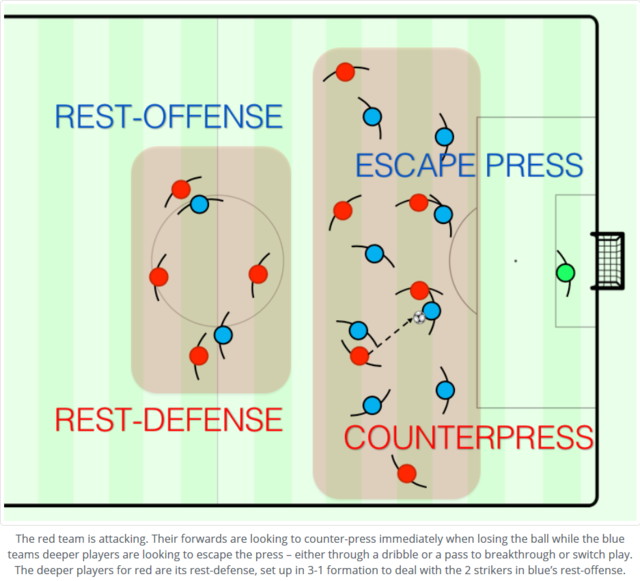
赤チームは攻撃的である.フォワードはボールを失ったときにすぐにカウンタープレスをかけようとし、青チームの深い位置にいる選手はドリブルやパスでプレスを逃れて突破したり、プレーを切り替えようとしている。赤チームの深い位置にいる選手は残りのディフェンスであり、青チームの残りのディフェンスにいる2人のストライカーに対応するために3-1のフォーメーションでセットアップされている。
In response, instead of applying immediate pressure to suffocate opponent counterattacks, coaches began to develop ideas on how to defend against opponent counters better. Mourinho for example famously spoke about that he always sought to have 5 players prepared in deeper positions for the opponent counterattack. Bielsa has mentioned that he prefers to have 1 more player in a defensive position than the opponent has attackers. Coaches could vary on if they approach this concept of rest-defense in a more numerical, “man-to-man,” or “zonal” manner.
This approach more effectively prevented breakthroughs behind the defense when opponents were counterattacking but did little to prevent the opponent from progressing into the opposite half of
the field to begin their positional attack if they had not been fast enough to expose the transitional organization of the retreating team.
In the modern game, the top teams are showing their ability not only to cover the potential breakthroughs behind the defense of counterattacks but also to apply immediate pressure on the counterattack to prevent it from ever being born in the first place. This created far longer periods of attacking in the opponent half for the more dominant teams (i.e. Pep Guardiola’s Manchester City). Counterattacks would need to evolve if they were going to more consistently escape pressure and break behind the opponent’s transitional organization and domination over the game.
これに対して、監督たちは、相手のカウンター攻撃を窒息させるためにすぐにプレッシャーをかけるのではなく、相手のカウンターからより良い守備をするためのアイデアを開発するようになった。例えばモウリーニョは、相手の反撃に備えて常に5人の選手を深い位置に用意することを求めていたことを有名に語っていた。ビエルサは、相手の攻撃陣よりも守備的なポジションに1人多くの選手を配置することを好むと述べている。この休息守備の概念を、より数値的に、あるいは「マンツーマン」、あるいは「ゾーン」的にアプローチするかどうかは、コーチによって異なるだろう。
このアプローチは、相手が反撃しているときにディフェンスの背後での突破をより効果的に防ぐことができたが、相手が退却するチームの過渡的な組織を暴くために十分な速さを持っていなければ、相手がフィールドの反対側の半分に進んでポジション攻撃を開始することを防ぐことはほとんどできなかった。
現代のゲームでは、トップチームは反撃の守備の背後にある潜在的な突破口をカバーするだけでなく、反撃に即座にプレッシャーをかけてそもそも反撃が生まれないようにする能力を発揮している。これにより、より支配的なチーム(ペップ・グアルディオラのマンチェスター・シティなど)では、相手ハーフでの攻撃期間がはるかに長くなった。カウンターアタックは、より一貫してプレッシャーから逃れ、相手の過渡的な組織とゲームを支配する背後を突破するためには、進化する必要があるだろう。
The Classic Counterattack
クラシックなカウンターアタック
If we look at the last two decades of football overall, the
most popular formations have been variants of the 4-4-2, 4-2-3-1, and 4-3-3. These would typically result in 4-4-2, 4-4-1-1, and 4-1-4-1 out of possession respectively. Typical counterattacks would arise out of these defensive formations – Peter Krawietz, Jurgen Klopp’s assistant coach and video analyst (also known as “The Eye”), has said in the past that Liverpool had to move past the “classic, random counterattacking situation” and create something more systematic. Meaning, counterattacks would simply be a result of fast forward
progression of the ball in transition from these deeper and more defensive shapes, with no seemingly explicit or clear method of creating the counterattack itself.
This resulted in counterattacks that relied heavily on the striker(s) and/or the attacking midfielder to receive the ball and progress the team forward, while the wingers and central midfielders may or may not arrive in time to support the transitional attack. With talented players and willing runners, this is normally enough to create very dangerous attacks in this short window of time.
If we take teams such as Atletico Madrid under Diego Simeone or Leicester City under Claudio Ranieri for example, they defended in compact 4-4-2 formations which were more often in the midfield or defensive portion of
the field. Once the ball was won, they sought to progress very quickly into their front 2 players to launch a counterattack. Based on the profile of the players, the method of attack would be different. If you have a striker such as Jamie Vardy who is extremely fast and with intelligent movements, the team would look immediately to play the ball into depth on the side of
the field which Vardy was running into out of the center while the opposite striker and winger filled the center and opposite channels.
過去20年間のサッカー全体を見てみると、最もポピュラーなフォーメーションは4-4-2、4-2-3-1、4-3-3のバリエーションである。これらは通常、それぞれ4-4-2、4-4-1-1、4-1-4-1のアウトオブポゼッションとなる。ユルゲン・クロップのアシスタントコーチであり、ビデオアナリストでもあるピーター・クロイツ(別名 "ザ・アイ "とも呼ばれる)は、リバプールは "古典的な、ランダムな反撃の状況 "を克服し、よりシステマティックなものを作らなければならないと過去に言っていた。つまり、カウンターアタックは、これらのより深く、より守備的な形からのトランジションでのボールの早送りの結果であり、反撃自体を作り出す明確な方法がないように見えたのだ。
その結果、ストライカーや攻撃的MFがボールを受けてチームを前進させる一方で、ウイングや中央のMFがトランジションの攻撃をサポートするために間に合うかどうかは別として、ストライカーや攻撃的MFに大きく依存したカウンターアタックになってしまっていたのである。才能ある選手と意欲的なランナーがいれば、この短い時間の中で非常に危険な攻撃を生み出すことができる。
例えば、ディエゴ・シメオネ監督下のアトレティコ・マドリードやクラウディオ・ラニエリ監督下のレスター・シティのようなチームを例に挙げると、彼らはコンパクトな4-4-2のフォーメーションで守備をしており、中盤や守備的な部分での守備が多かった。ボールを獲得すると、彼らは反撃を開始するために前線の2人の選手に非常に迅速に進行しようとしました。選手のプロフィールに基づいて、攻撃の方法は異なるだろう。ジェイミー・バーディのように非常に速く、知的な動きをするストライカーがいれば、チームはすぐにバーディがセンターの外に走り込んでいたサイドの深さにボールを流し込み、反対側のストライカーとウインガーがセンターと反対側のチャンネルを埋めていくことに目を向けるだろう。
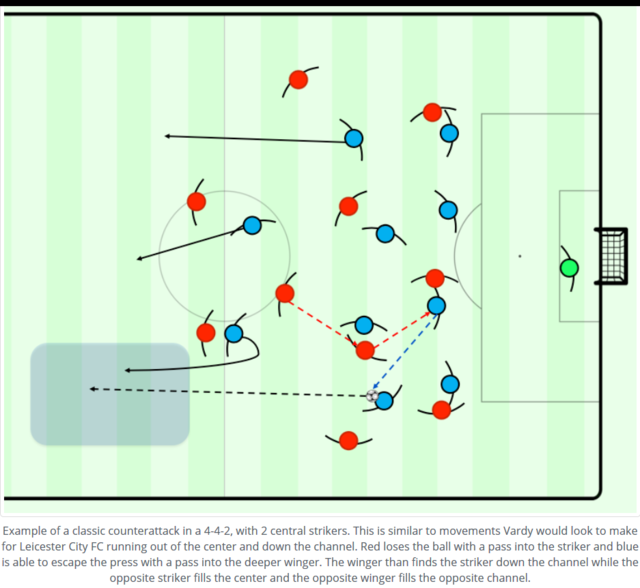
2人のセントラルストライカーがいる4-4-2の典型的な反撃の例。これはバルディがレスター・シティFCのために、中央を飛び出してチャンネルを下っていく動きに似ている。赤はストライカーへのパスでボールを失い、青はより深い位置にいるウインガーへのパスでプレスから逃れることができる。反対側のストライカーが中央を埋めると反対側のウインガーが反対側のチャネルを埋める間、チャネルの下にストライカーを見つけるよりもウインガー。
If you have a striker such as Diego Costa who is fast with good movement in his own right (especially when he was younger), but physically a larger and stronger player than someone like Vardy – the team may look immediately to play the ball into the feet of Costa in the center or in the channel as he shields off his defender so that he can lay the ball off into his partner striker, an attacking midfielder, or even midfielders/wingers running from their deeper defensive positions.
If we consider a team such as
Borussia Dortmund under Jurgen Klopp for example, they also defended in a 4-4-2 or 4-4-1-1 very often, but with an attacking midfielder rather than another striker. Players such as Mario Gotze or Shinji Kagawa would move in support of the main striker such as Robert Lewandowski. When the team would defend in their compact midfield block and then win the ball, they could look to find Mario Gotze in a pocket of space behind the opponent midfielders in a “playmaking position” to then run with the ball toward the goal and play the striker or wingers running from deep into the channels outside the central defenders and behind the defense. The team may also look for a ball directly into Lewandowski so that he can hold the ball up (such as Costa in our earlier example) and then play it into Gotze to dribble forward with speed or into a winger arriving from a deeper position.
ディエゴ・コスタのように、彼自身の動きが速くて(特に彼が若かった頃は)良いが、身体的にはバーディのような選手よりも大きくて強いストライカーがいる場合、チームはすぐに中央やチャンネルでコスタの足元にボールを流し、彼がディフェンダーを遮っている間に、彼がパートナーのストライカーや攻撃的なミッドフィールダー、あるいは守備の深い位置から走り出すミッドフィールダーやウイングにボールを預けることができるようにすることに目を向けるかもしれない。
例えば、ユルゲン・クロップ監督時代のボルシア・ドルトムントのようなチームを考えてみると、4-4-2や4-4-1-1のような守備をすることが多いが、ストライカーではなく攻撃的なMFを起用している。マリオ・ゴッツェや香川真司のような選手が、ロベルト・レヴァンドフスキのようなメインストライカーのサポート役として動くこともあった。チームがコンパクトな中盤のブロックで守備をしてボールを獲得すると、相手の中盤の後ろのスペースのポケットにいるマリオ・ゴッツェを「プレイメイキング・ポジション」で見つけて、ボールを持ってゴールに向かって走り、中央の守備陣の外、守備陣の後ろのチャンネルに深い位置から走るストライカーやウインガーをプレーさせることができるだろう。また、チームはレヴァンドフスキに直接ボールを入れてボールを保持できるようにして(先ほどのコスタのように)、ゴッツェにボールを流してスピードを持ってドリブルで前進したり、深い位置から到着したウインガーにボールを流したりすることもある。

4-4-1-1の典型的なカウンターアタックの例。これは、ユルゲン・クロップ監督時代のボルシア・ドルトムントの反撃に似ている。赤は同じようにボールを失い、今、中央のディフェンダーは、プレスを逃れるために、可能であれば、ラインの間にゴッツェへのパスを見つけようとすることができるか、または再びウィンガーへのパスを見つけることができます。ストライカーは、ボールを受け取るために中央の外に移動することができますし、それをシールドし、ウインガーや攻撃的なミッドフィルダーに横たわっています。攻撃的なミッドフィールダーが後ろにランナーがいるディフェンスでドリブルで前進したら(プレイメーカーの位置)、彼は満たされている3つのチャネルのいずれかを介してボールを渡すように見ることができます。
These counterattacking methods rely on your few forward players in the rest-offense or rest-attack (meaning, the portion of your team not directly interacting with the defending play and can look to be outlets for teammates escaping the opponent counter-press) to receive, pass, and dribble well against a higher number of defenders through the center of
the field. An evolution we began to see more often in football for the dangerous counterattacking teams is the purposeful use of the “gambling” winger.
これらの反撃方法は、フィールドの中央を通ってより多くのディフェンダーに対して、受信、パス、およびドリブルをうまく行うために、残りのオフェンスまたは残りの攻撃(意味、あなたのチームの部分は、直接守備のプレーと相互作用しておらず、相手のカウンタープレスをエスケープするチームメイトのためのアウトレットに見えることができます)であなたの少数のフォワードプレーヤーに依存しています。我々は危険な反撃チームのためのサッカーでより頻繁に見るようになった進化は、"ギャンブル "ウインガーの意図的な使用です。
The “Gambling” Wingers/Inside Forwards
"ギャンブル性 "のあるウイング/インサイドフォワード
A “gambling” winger or inside forward is one that purposefully omits their defensive duties on their side of
the field in order to better position and prepare themselves to attack the opponent as soon as the ball is won. This can happen in
most teams randomly throughout a match as a winger is late to get back into defense, but what makes it a clear strategy is when both the coach and the player understand this role. The coach tries to make systematic adjustments to the rest of the team to cope with the lack of typical defensive presence, while the player is more actively looking for space to exploit and not worried about having to run back and join the team every time.
The best example of this role for counterattacking teams is Cristiano Ronaldo both at Manchester United and Real Madrid. While many of the goals Ronaldo scored were from attacking crosses in a positional organization or set pieces such as free kicks, penalties, and crosses from corner kicks, he owes many of his best chances to score to his role during defending and counterattacking.
ギャンブル性のある」ウインガーやインサイドフォワードとは、ボールを獲得したらすぐに相手を攻撃できるようにポジショニングを良くして準備をするために、意図的にフィールドのサイドでの守備的な役割を省くことを意味します。これはほとんどのチームでは、ウィンガーが守備に戻るのが遅れているため、試合中にランダムに起こる可能性があるが、それを明確な戦略とするのは、コーチと選手の両方がこの役割を理解しているときである。コーチは典型的な守備的な存在感の欠如に対処するためにチームの残りの部分を組織的に調整しようとし、一方で選手はより積極的にスペースを探し、毎回走って戻ってチームに参加しなければならないことを心配していません。
カウンター攻撃チームのためのこの役割の最も良い例は、マンチェスター・ユナイテッドとレアル・マドリードのクリスティアーノ・ロナウドである。ロナウドが獲得したゴールの多くは、攻撃的なポジションでのクロスや、フリーキック、ペナルティ、コーナーキックからのクロスなどのセットプレーからのものだったが、彼は守備とカウンター攻撃の間に彼の役割を果たすことで、多くの得点のチャンスを得ているのだ。
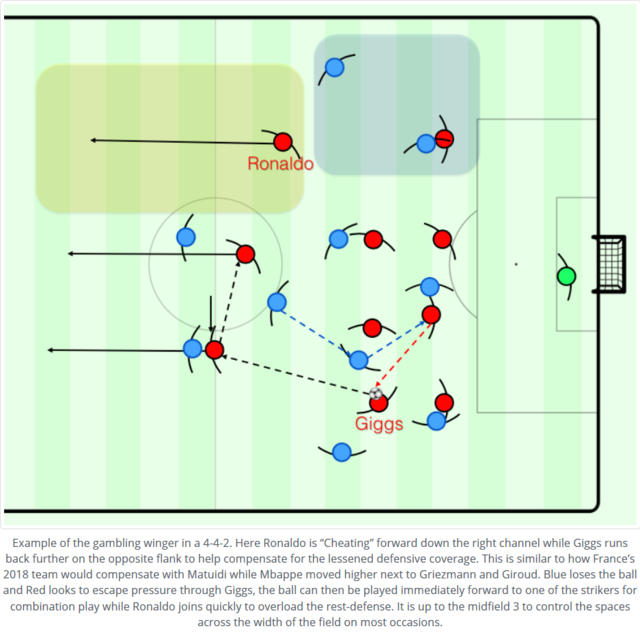
4-4-2でのギャンブルウインガーの例。ここでは、ギグスが減少した守備範囲を補うために反対側の側面でさらに後ろに走る間、ロナウドは右チャンネルを下って「ごまかし」ながら前進している。これは、2018年のフランスのチームが、ムバッペがグリーズマンとジルーの隣に高い位置に移動している間に、マテュイディでどのように補償するかに似ています。青はボールを失い、赤はギグスを通して圧力を逃れようとしているが、ボールはすぐにストライカーの一人に前に出てコンビネーションプレーをすることができ、一方でロナウドはすぐに合流して残りの守備に負荷をかけている。ほとんどの場合、フィールドの幅の向こう側のスペースをコントロールするのは、中盤の3人にかかっている。
Another (more recent) example of this role would be Kylian Mbappe with the 2018
World Cup winning French national team. His role in defending and counterattacking as the right-winger allowed him to be more immediately prepared to threaten into depth on the wings when his team won the ball, resulting in many dangerous attacks for him during his breakout performances in the 2018
World Cup.
Using a wide player which remains forward and lurks for the weak points in a team’s transitional organization allows for more offensive presence than what we detailed as a “classic counterattacks,” and with more immediate offensive threats in this phase of the game, the likelihood of a successful counterattack goes up, the compromise is how a team handles the defensive phase.
With France’s 2018 team, on the opposite flank of Kylian Mbappe was Blaise Matuidi, a player which normally played as a defensive midfielder or a “box to box” central midfielder – meaning it was far more natural for Matuidi to provide more defensive cover and tuck into the midfield to form a line of 3 with central midfielders N’Golo Kante and Paul Pogba. This made it less dangerous for the defense when Mbappe would maintain a higher position on the right flank while Antoine Griezmann and Olivier Giroud were the striking duo through the center, with Griezmann acting more like a second striker or playmaker while Giroud was more of a target man who used his body to block defenders and used his combination ability to set up his teammates. What normally would have looked like a 4-4-1-1 looked more like an asymmetric 4-3-1-2 or 4-3-2-1, providing more offensive threat in transition.
この役割のもう一つの(より最近の)例は、2018年ワールドカップで優勝したフランス代表チームのキリアン・ムバッペだろう。右ウインガーとして守備とカウンター攻撃の役割を担ったことで、チームがボールを獲得したときにすぐにウイングの奥深くまで脅かす準備ができるようになり、結果として2018年ワールドカップでのブレイクアウトのパフォーマンスで多くの危険な攻撃が彼にもたらされた。
前方に残り、チームの過渡期の組織の弱点に潜むワイドプレーヤーを使用することで、我々が「古典的な反撃」として詳述したものよりも、より多くの攻撃的な存在感を得ることができ、ゲームのこのフェーズでより即時性のある攻撃的な脅威があれば、成功した反撃の可能性は高くなりますが、妥協点は、チームが守備のフェーズをどのように処理するかということになります。
2018年のフランスのチームでは、キリアン・ムバッペの反対側のフランクには、通常は守備的MFとしてプレーするか、「ボックス・トゥ・ボックス」の中央MFとしてプレーするブレイズ・マトゥイディがいた。アントワーヌ・グリエズマンとオリビエ・ジローは、中央からの攻撃的なデュオであり、グリエズマンはセカンドストライカーやプレイメーカーのような役割を果たし、ジローはどちらかというとターゲットマンであり、ディフェンダーをブロックするために体を使い、チームメイトをセットアップするためにコンビネーションの能力を発揮していた。通常は4-4-1-1のように見えていたものが、4-3-1-2や4-3-2-1のように非対称な4-3-1-2や4-3-2-1のように見え、トランジションでより多くの攻撃的な脅威を提供しています。
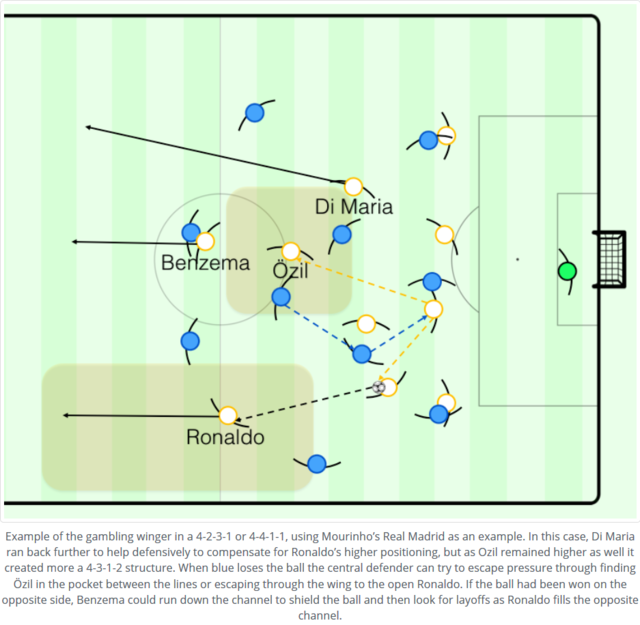
モウリーニョのレアル・マドリードを例に、4-2-3-1または4-4-1-1でのギャンブルウインガーの例。この場合、ディ・マリアはロナウドのポジショニングが高くなったことを補うために、さらに後ろに下がって守備を助けたが、オジルが高くなったことで、より4-3-1-2の構造ができあがった。青がボールを失うと、中央のディフェンダーは、ラインの間のポケットにいるエジルを見つけたり、ウイングを通って開いたロナウドに逃げ込んだりして、圧力を逃れようとすることができる。反対側でボールを獲得した場合、ベンゼマはチャンネルを走ってボールを遮蔽し、ロナウドが反対側のチャンネルを埋めている間にレイオフを探すことができる。
At Manchester United, Cristiano Ronaldo had Ryan Giggs on the opposite flank to balance his higher positioning. At Real Madrid, he had players such as Angel Di Maria, Gareth Bale, and Isco Alarcon who would balance his higher positioning by dropping in next to the deeper central midfielders. At Manchester United, Sir Alex Ferguson sought to defend
most often in a 4-4-2, and with Ronaldo staying higher the shape more often looked like an asymmetric 4-3-3 shape as Giggs tucked inside. Under Mourinho at Real Madrid, the team
most often defended in a 4-4-1-1, but with Ronaldo remaining higher it more often looked like an asymmetric 4-3-1-2 or 4-3-2-1 as Mesut Ozil was the attacking midfielder and Karim Benzema or Gonzalo Higuain was the striker. Under Ancelotti at Real Madrid, the team looked to defend in a 4-1-4-1, but due to Ronaldo lurking higher in the left channel and Bale dropping deeper on the right flank, the team looked more often like a lopsided 4-4-2. Finally, under Zidane at Real Madrid, the team began using a 4-3-1-2 system in which Isco was the attacking midfielder. When out of possession Isco would look to
drop into the midfield line to form a 4-4-2 and allow Ronaldo to remain higher.
マンチェスター・ユナイテッドでは、クリスティアーノ・ロナウドはライアン・ギグスを反対側のフランクに配置し、高い位置でのバランスを取っていた。レアル・マドリードでは、アンヘル・ディ・マリア、ガレス・ベイル、イスコ・アラルコンなどの選手を起用していたが、これらの選手は、より深い位置にいる中央のミッドフィールダーの隣に入ることで、より高いポジショニングのバランスを取っていた。マンチェスター・ユナイテッドでは、サー・アレックス・ファーガソンは4-4-2での守備を求めていたが、ロナウドが高い位置にいることで、ギグスが中に入ることで、非対称な4-3-3のような形になることが多かった。モウリーニョ監督の下、レアル・マドリードでは、チームは4-4-1-1で守ることが多かったが、ロナウドが高い位置にいるため、メズート・オジルが攻撃的MFで、カリム・ベンゼマやゴンサロ・ヒグアインがストライカーだったため、非対称な4-3-1-2や4-3-2-1のように見えることが多くなった。レアル・マドリードのアンチェロッティ監督の下では、チームは4-1-4-1の守備をしていたが、ロナウドが左チャンネルの高い位置に潜み、ベイルが右サイドの深い位置に下がっていたため、チームはより多くの場合、左右対称の4-4-2のように見えていた。最後に、レアル・マドリードのジダン監督の下で、チームはイスコを攻撃的MFとする4-3-1-2のシステムを使い始めた。領地を離れると、イスコは中盤のラインに下がり、4-4-2を形成し、ロナウドが高い位置に留まることを可能にした。
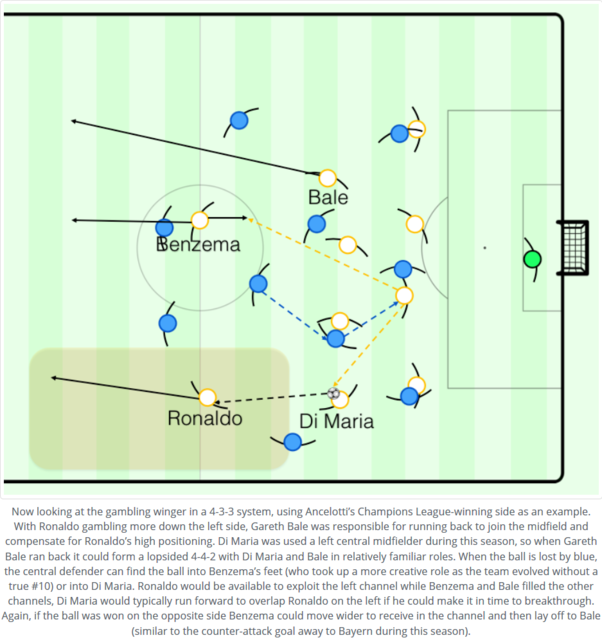
今度はアンチェロッティ監督のチャンピオンズリーグ優勝チームを例に、4-3-3のシステムでのギャンブル性の高いウインガーを見てみよう。ロナウドが左サイドをよりギャンブル的に下がる中、ガレス・ベイルは中盤に入り、ロナウドの高いポジショニングを補うためにランニングバックを担当していた。今シーズンはディ・マリアが左サイドの中央MFとして起用されていたので、ガレス・ベイルが後ろに走ると、ディ・マリアとベイルが比較的慣れ親しんだ役割を果たすことになるという、不公平な4-4-2を形成することができたのだ。ブルーがボールを失うと、中央のディフェンダーはベンゼマ(真の10番がいないチームの進化に伴い、より創造的な役割を担うようになった)の足元にボールを入れるか、ディ・マリアにボールを入れることができる。ベンゼマとベイルが他のチャンネルを埋めている間、ロナウドは左のチャンネルを利用することができ、ディ・マリアは通常、前に走って左のロナウドにオーバーラップして突破口を開くことができれば、それを利用することができる。また、反対側でボールを獲得した場合は、ベンゼマがより広く動いてチャンネル内でボールを受け、ベイルにレイオフすることも可能だった(今シーズンのバイエルン戦での反撃のゴールに似ている)。
When a team is defending a fast counterattack, they will prioritize the center of
the field as it’s the
most direct path to goal – from there they will try to force the play wider and delay the attack (or win the ball if there is a possible moment to tackle) until the rest of the team can join the defense and re-organize. Because there are fewer defenders when trying to stop a counterattack and a focus on protecting the center, counterattacks do not have to be very wide to stretch defenses in this phase. You will rarely find a counterattack that has extremely wide forwards (toward the touchlines) getting in behind, rather the wide players in a counterattack are usually at the width of the box – just inside of space between fullbacks and center backs.
チームが速い反撃を守ろうとしているとき、チームはゴールへの最も直接的なパスがあるフィールドの中央を優先します-そこから、残りのチームが守備に加わって再編成できるようになるまで、プレーを強制的に広くして攻撃を遅らせ(タックルの瞬間があればボールを獲得する)、攻撃を遅らせようとします。反撃を止めようとするときの守備陣の数が少なく、センターを守ることに重点が置かれているため、この局面では反撃は守備を伸ばすために非常に広くする必要はない。反撃では、(タッチラインに向かって)極端に幅の広いフォワードが後ろに入ってくるような反撃はほとんど見られませんが、むしろ反撃で幅の広い選手は、通常、ボックスの幅、つまりフルバックとセンターバックの間のスペースのちょうど内側にいます。
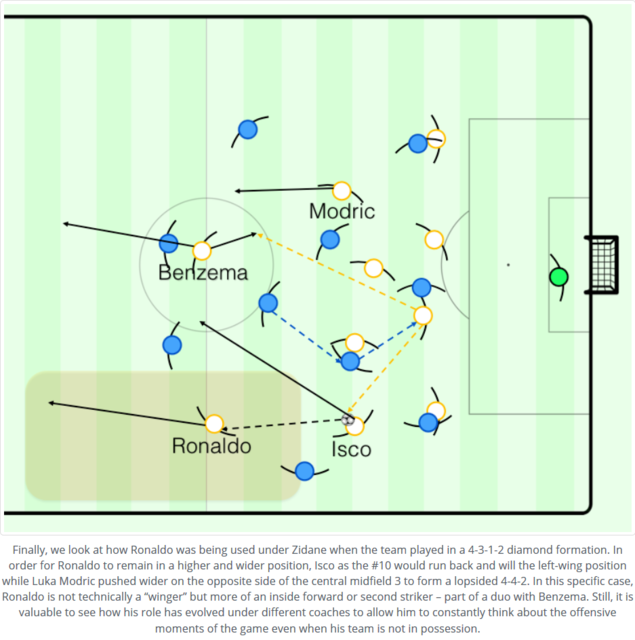
最後に、チームが4-3-1-2のダイヤモンドフォーメーションでプレーしていたとき、ジダン監督の下でロナウドがどのように使われていたかを見てみよう。ロナウドがより高く、より広い位置に留まるためには、#10としてのイスコが後ろに下がって左ウイングのポジションを取る一方で、ルカ・モドリッチが中央の中盤の3番の反対側でより広い位置に押し出して4-4-2を形成していたのだ。この特定のケースでは、ロナウドは技術的には "ウインガー "ではなく、むしろインサイドフォワードやセカンドストライカーとして、ベンゼマとのデュオの一部となっている。それでも、チームがボールを持っていない時でも、攻撃的な瞬間を常に考えられるようにするために、様々な監督の下でロナウドの役割がどのように進化してきたかを見ることは貴重なことである。
For this reason, when a gambling winger or inside forward is added to the typical 2 forward players in the center, it can create overload problems for a transitional defense. Either a team keeps more players back when attacking and has less offensive presence, or they risk the extra forward exploiting space behind the rest-defense. The space
most often exploited by these players is the spaces behind fullbacks that move higher in the possession and offer width, leaving them with a large distance to cover in a short amount of time to get back and prevent the gambling winger from getting free. Gambling wingers are typically played deep in behind the defense with the first or second pass due to being immediately free.
More recently we have seen a team that created a pressing
scheme (as opposed to a covering
scheme like with the gambling wingers) that purposefully puts the fastest and
most threatening scorers in the team in dangerous counterattacking positions for immediate passes behind, but without having to gamble with defensive solidity.
このため、中央の典型的な2人のフォワードプレイヤーにギャンブルウインガーやインサイドフォワードが加わると、トランジショナルディフェンスにオーバーロードの問題が生じる可能性があります。チームは攻撃時に多くの選手を後ろに残して攻撃的な存在感を薄めてしまうか、またはフォワードが残りのディフェンスの後ろのスペースを利用してしまう危険性があります。このようなプレーヤーが最もよく利用するスペースはフルバックの後ろのスペースで、フルバックはポゼッションの高い位置に移動して幅を提供し、短い時間でカバーできる距離を確保してギャンブルウインガーが自由になるのを防ぎます。ギャンブルウインガーは、すぐにフリーになるため、1回目か2回目のパスで守備の奥深くでプレーするのが一般的です。
最近では、(ギャンブルウインガーのようなカバーリングではなく)プレッシングのスキームを作ったチームを見かけることがありますが、これは、チーム内で最も速く、最も脅威的な得点者を危険な反撃ポジションに置き、すぐにパスを受けられるようにしますが、守備の堅実さに賭ける必要はありません。
The Modern Approach to Pressing for Counterattacks
カウンターアタックのためのプレスの現代的な考え方
This team would be Jurgen Klopp’s Liverpool FC. As I mentioned earlier, Peter Krawietz had spoken on the topic of the classic counterattack vs. a more systematic approach, here is his full quote from
Raphael Honigstein’s piece on The Athletic:
このチームはユルゲン・クロップのリバプールFCになるだろう。先に述べたように、ピーター・クラウィーツは古典的な反撃 vs. よりシステマティックなアプローチのトピックについて話していたが、ここではアスレチックに掲載されたラファエル・ホニグスタインの作品からの彼の完全な引用である。
“We realized how unbelievably fast Salah was and thought a lot about ways to bring his strengths to bear on the pitch. In order to get the
most out of his ability to go deep, we needed to move beyond the classic, random counter-attacking situation and instead prepare situations for him systematically…You can structurally reduce the attacking game to two or three typical situations.
Assuming the opponent has the ball, we need to
talk about active defending. This doesn’t mean protecting your own goal but trying to create situations in which you can win the ball. In the back of your head, you always want to exploit these situations, be it high up or in the middle of the pitch. Once you win the ball, automated procedures kick in: If you defend systematically, you know where your team-mates are.
You can then steer the opponent’s build-up in the direction you want them to. You are setting up situations you will have crafted during the preparation for the match. You know how the opponent is building up and you know whether they are taking the full-backs forward or not.”
"私たちは、サラーのスピードが信じられないほど速いことに気付き、彼の強みをピッチ上で生かす方法をたくさん考えた。彼の深いところに行く能力を最大限に引き出すためには、典型的なランダムなカウンター攻撃の状況を超えて、彼のためのシチュエーションを体系的に準備する必要があった...。
相手がボールを持っていると仮定して、積極的なディフェンスの話をする必要があります。これは自陣ゴールを守るという意味ではなく、ボールを獲得できる状況を作ろうとすることです。頭の中では、高い位置であろうとピッチの中央であろうと、常にこのような状況を利用したいと考えている。ボールを獲得すれば、自動化された手順が実行される。計画的に守れば、チームメイトがどこにいるかがわかる。
そうすれば、相手のビルドアップを自分の望む方向に誘導することができる。あなたは、試合の準備の間に作られた状況を設定しています。相手がどのようにビルドアップしているのか、フルバックを前に出しているのかどうかを知ることができるのだ。"
The 3 situations which he mentions in this quote for attacking are: counterattacking situations, build-up situations against a press, and circulation against an organized deep block in general. It is clear that Liverpool seeks to prepare situations not only for Salah but also for Mane in a systematic fashion. They don’t simply leave Salah or Mane in offensive positions to gamble and have the rest of the team cover, but they actively apply pressure and cut off passing lanes in a way that both these forwards are being used in the defensive
scheme while at the same time being positioned to exploit the spaces behind opponent fullbacks instantly if the possession of the ball turns over.
The team seeks to lessen the time and space the opponent has on the ball to win it back earlier and then exploit their transitional organization. The gambling winger approach as detailed above relied on the rest of the team working to cover for the extra offensive player, and more often the team would defend deeper. In this case, the entire team works as a unit and can maintain a higher field position while actively forcing opponent mistakes rather than covering options and waiting for a mistake. As Krawietz mentions, when the ball is won the counterattack can be automatic because the team defended in a systematic fashion to have Salah and Mane in dangerous positions.
Liverpool presses in a clear 4-3-3 formation, the wingers remain in higher positions rather than dropping next to the central midfielders in this
scheme. The central striker, Roberto Firmino, has the main role of dropping deeper to cover the opponent defensive midfielders while the 3 central midfielders look to cover the center and press out to the wings should the ball arrive there – this effectively creates a diamond in the center of the pitch. The back 4 remains compact and connected to cover the opponent strikers and wingers if a situation arises where the fullback or center back need to press higher into midfield to cover an open opponent, the rest of the back 4 shifts across to form a compact back 3 towards the ball.
この名言の中で彼が攻撃面で言及している3つのシチュエーションとは、反撃のシチュエーション、プレスに対するビルドアップのシチュエーション、組織的なディープブロックに対するサーキュレーションの一般的なシチュエーションである。リバプールがサラーだけでなく、マネのためにも組織的に状況を整えようとしていることは明らかだ。サラーやマネを単に攻撃的なポジションに置いてギャンブルをさせ、残りのチームにカバーさせるのではなく、積極的にプレッシャーをかけ、パスのレーンを遮断することで、両フォワードが守備的なスキームで使われるようにすると同時に、ボールの所有権がひっくり返れば、相手のフルバックの背後にあるスペースを瞬時に利用できるように配置されているのだ。
チームは、相手がボールを持っている時間とスペースを減らして早めにボールを奪い返し、その後、彼らの過渡的な組織を利用しようとしています。上記のようなギャンブルウインガーのアプローチでは、チームの残りの部分が余分な攻撃的プレーヤーをカバーするために働き、より多くの場合、チームはより深いディフェンスをすることになります。この場合、チーム全体がユニットとして機能し、オプションをカバーしてミスを待つのではなく、積極的に相手のミスを強要しながら、より高いフィールドポジションを維持することができる。クラウィーツが言及しているように、ボールを獲得すると、チームはサラーとマネを危険なポジションに置くために組織的に守備をしていたため、反撃が自動化されることがある。
リバプールは明確な4-3-3のフォーメーションでプレスをかけ、このスキームでは、ウイングは中央のミッドフィルダーの隣に下がるのではなく、より高い位置にいる。中央のストライカーであるロベルト・フィルミーノは、相手の守備的なミッドフィルダーをカバーするために深く下がり、3人の中央のミッドフィルダーが中央をカバーし、そこにボールが届くと翼にプレスをかけるという主な役割を担っている。バック4はコンパクトなままで、相手のストライカーやウイングをカバーするために、フルバックやセンターバックが中盤の高い位置でプレスをかけてオープンになった相手をカバーしなければならない状況が発生した場合、バック4の残りの部分は、ボールに向かってコンパクトなバック3を形成するために横に移動します。

リバプールの基本的なスターティング構造と役割は、4-1-2-3のフォーメーションをとっているブルーに対して4-3-3のプレスをかけることである(リバプールのスキームは、もちろん相手の構造やスタイルに応じて少しずつ変化する)。フィルミーノは、相手の守備的MFへのパスをカバーするために後ろに走っていくことができ、中央のMFにフリーの選手を与えている。マネとサラーは、前線に3人の明確なラインを作るために高い位置にいるが、相手のフルバックへのパスをマンマークではなくブロックしようとする。サラー側の中央ディフェンダーがボールを受けて距離が近くなると、パスをワイドにブロックしながら走り出すのがサラーの合図で、強制的にアクションを起こさせる。マネは高い位置をキープして、反対側のセントラルディフェンダーやフルバックへの交代を魅力的でないものにしている。
The main role of the wingers, Salah and Mane, is to steer the opponent’s build-up as Krawietz mentioned. Their main focus is to position relative to the opponent’s fullbacks and then press toward the opponent’s central defenders while covering the passing lane to the fullbacks. This creates an interesting situation for opponent fullbacks – the central midfield 3 of Liverpool are in the middle of
the field and your winger just left you to go and press a central defender. This leaves more space for you to receive the ball, so you push higher. The only problem is that the winger is blocking the direct passing lane into you – so in order to reach you, your central defender will have to play a high pass which takes longer to
drop onto your feet, or play into the center of
the field in order to get the ball out to you.
If the central defender chooses the first option and chips the ball over to you, the nearest central midfielder immediately sprints out to you while Liverpool’s defensive midfielder (typically Fabinho) covers the pressing central midfielder’s initial position. Firmino is still covering the area around the defensive midfielder and now the winger (for this example Salah) turns around and starts closing down toward the ball while blocking a back pass into the central defender. A double-team is fast approaching you on the wing without a clear
possibility to back pass as Liverpool forced you forward and away from your goalkeeper or central defenders and all other passing options into the middle of
the field are covered due to the diamond. It is a pressing trap! If the ball is recovered by Liverpool Salah and Mane are already positioned higher than the opponent’s fullbacks and wider than the opponent central defenders, the solution is usually an immediate pass into depth in the channel.
ウインガーであるサラーとマネの主な役割は、クロイツが言っていたように、相手のビルドアップの舵取りをすることだ。彼らの主な役割は、相手のフルバックに対して相対的にポジションを取り、フルバックへのパスレーンをカバーしながら相手中央の守備陣に向かってプレスをかけることだ。これは相手のフルバックにとって興味深い状況を作り出す - リバプールの中央中盤の3人がフィールドの中央にいて、あなたのウインガーはあなたを残して中央のディフェンダーに向かってプレスをかけるだけです。これはあなたがボールを受け取るためのより多くのスペースを残しているので、あなたはより高くプッシュします。唯一の問題は、ウインガーがあなたへの直接のパスレーンをブロックしていることです - あなたに到達するためには、あなたの中央のディフェンダーは、あなたの足に落ちるのに時間がかかる高いパスをプレイするか、あなたにボールを取得するためにフィールドの中央にプレイする必要があります。
中央のディフェンダーが最初のオプションを選択して、ボールをあなたのところにチップオーバーした場合、リバプールの守備的MF(通常はファビーニョ)がプレスをかけている中央のMFの最初の位置をカバーしている間に、最も近い中央のMFがすぐにあなたのところに飛び出してきます。フィルミーノはまだ守備的MFの周りをカバーしていますが、今度はウィンガー(この例ではサラー)が振り向き、中央の守備陣へのバックパスをブロックしながらボールに向かって迫り始めます。ダブルチームは、リバプールがあなたを強制的に前方に、あなたのゴールキーパーや中央のディフェンダーから離れて、フィールドの中央への他のすべてのパスの選択肢がダイヤモンドのためにカバーされているように、バックパスをする明確な可能性がなく、ウイングであなたに高速で近づいています。それはプレッシングの罠だ! ボールがリバプールのサラーとマネによって回収された場合、すでに相手のフルバックよりも高く、相手の中央守備陣よりも広い位置に配置されている場合、解決策は通常、チャネル内の深さへの即時パスです。
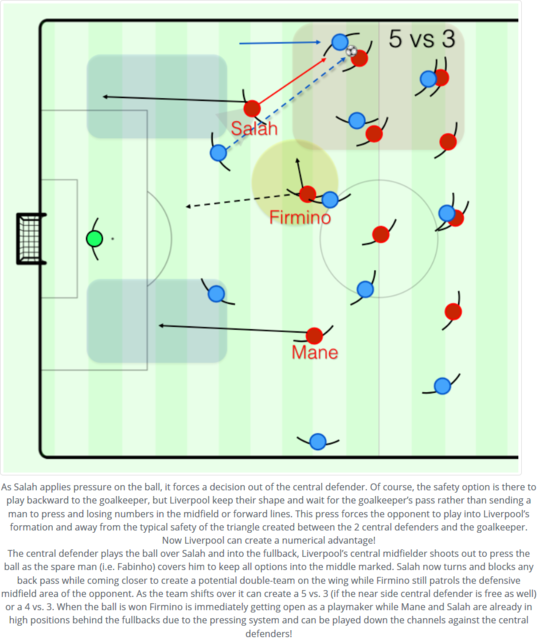
サラーがボールにプレッシャーをかけると、中央のディフェンダーに決定機を押し出す。もちろん、ゴールキーパーに向かって後方でプレーするという安全の選択肢もあるが、リバプールはプレスに人を送り、中盤やフォワードラインで数を失うよりも、自分たちの形を保ち、ゴールキーパーのパスを待つ。このプレスは相手にリバプールのフォーメーションに入り込み、中央の2人の守備陣とゴールキーパーの間に作られた三角形の典型的な安全性から離れてプレーすることを強いる。これでリバプールは数的優位を築くことができる。
中央のディフェンダーがサラーの上を通ってフルバックにボールを流し込むと、リバプールの中央のMFがシュートを放ってボールを押し込み、スペアマン(ファビーニョ)が彼をカバーして中央へのすべてのオプションをマークしておく。サラーはウイングでダブルチームを作る可能性があることを確認しながら、フィルミーノが相手の守備的な中盤のエリアをパトロールしている間に、ターンしてバックパスをブロックしている。チームが交代すると、5対3(近くにいるセントラルディフェンダーがフリーの場合)、または4対3を作ることができる。 ボールを獲得すると、フィルミーノはすぐにプレイメーカーとしてプレーすることができ、一方で、マンとサラーはプレスシステムにより、すでにフルバックの後ろの高い位置にいて、セントラルディフェンダーに対してチャンネルを下ってプレーすることができる。
This is what Krawietz means when he says Liverpool seeks to set up situations that they crafted in preparation for the match, the team is prepared for how the opponent is building up and know whether the opponent’s fullbacks push higher or not.
If we look at the second option for the central defender, he chooses to pass into the center of
the field as the winger is coming towards him to press. The pass into the fullback is too dangerous, the pass back to the goalkeeper isn’t necessary, and the switch to the opposite central defender or fullback seems dangerous as Mane is covering a position between the two far side options – so the clearer option is a pass forward into midfield. Because Liverpool has a diamond in the center of
the field, they typically have an overload – so they react very aggressively on any pass into the center of
the field while having extra cover from a free central midfielder. The central midfielder can’t pass backward out of pressure as Liverpool’s wingers just pressed from there. If you manage to keep the ball during the reception of the pass and intense pressure, you can play it wide to the open fullback…but then a similar situation to the first one can occur if the players are not fast and clean enough in their execution. In theory, this pressing
scheme covers the
most dangerous options while having players in dangerous positions to counterattack immediately. In practice, it has proven extremely difficult to beat Liverpool, not only due to their great possession and counter-pressing game but also due to this pressing
scheme for their counterattacks. It cannot always be executed perfectly by them, but with high intensity in their running and the mentality to cover for any mistakes, it is very difficult to exploit them even when they don’t properly execute their pressing.
これは、リバプールが試合に向けて工作した状況をセットアップしようとしているというクラウィーツ監督の言葉が意味するところであり、チームは相手がどのようにビルドアップしているかに備えており、相手のフルバックが高い位置を押してくるかどうかを知っているということだ。
中央のディフェンダーの2つ目の選択肢を見てみると、ウィンガーがプレスをかけるために自分に向かってくるので、彼は中央へのパスを選択する。フルバックへのパスは危険すぎるし、ゴールキーパーに戻るパスは必要ないし、反対側のセントラルディフェンダーやフルバックへの切り替えは、マネが2つのファーサイドの選択肢の間のポジションをカバーしているので危険に思える--なので、より明確な選択肢は中盤への前方へのパスだ。リバプールはフィールドの中央にダイヤモンドを持っているので、彼らは典型的にオーバーロードを持っている - だから、彼らはフリーの中央MFから余分なカバーを持っている間に、フィールドの中央への任意のパスに非常にアグレッシブに反応します。リバプールのウイングがそこからプレスをかけるだけなので、中央MFはプレッシャーから後方にパスを出すことができない。パスを受けて激しいプレッシャーを受けている間になんとかボールをキープできれば、開いているフルバックにワイドに弾くことができるのだが......そうなると、選手たちの実行が迅速かつクリーンでないと、最初のものと似たような状況に陥る可能性が出てくる。理論的には、このプレッシングのスキームは、危険なポジションにいる選手がすぐに反撃できるようにしながら、最も危険な選択肢をカバーしている。実際のところ、リバプールに勝つのは非常に難しいことが証明されており、彼らの素晴らしいポゼッションとカウンタープレスのゲームのためだけでなく、彼らのカウンターアタックのためのこのプレスのスキームのためでもある。彼らによって常に完璧に実行されるわけではないが、彼らのランニングのインテンシティの高さと、ミスをカバーするメンタリティがあれば、彼らのプレッシングを適切に実行していない場合でも、彼らを搾取することは非常に難しい。
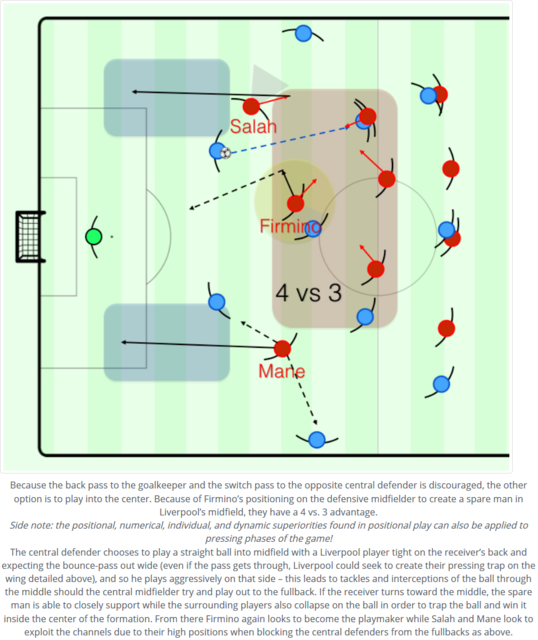
ゴールキーパーへのバックパスや、反対側の中央ディフェンダーへのスイッチパスは敬遠されるため、もう一つの選択肢は中央へのプレーだ。リバプールの中盤にスペアマンを作るためにフィルミーノが守備的MFにポジショニングしているため、4対3で優位に立っている。
余談:ポジショナルプレーに見られるポジション的な優位性、数的優位性、個人的な優位性、ダイナミックな優位性は、プレッシングの局面にも応用できる
中央のディフェンダーは、リバプールの選手がレシーバーの背中に密着した状態で中盤へのストレートボールをプレーすることを選択し、バウンドパスを期待している(パスが通ったとしても、リバプールは上述したウイングでのプレスの罠を作り出そうとする可能性がある)ので、そちら側でアグレッシブにプレーすることになる。レシーバーが中央に向かえば、スペアマンは、周囲の選手がボールをトラップし、フォーメーションの中央の内側でボールを獲得するために、ボールを崩しながら、密接にサポートすることができます。そこからフィルミーノが再びプレイメーカーとなり、サラーとマネは上記のようにフルバックから中央の守備陣をブロックする際に高い位置にいるために、チャンネルを利用するように見える。
While Liverpool typically has Firmino in the central playmaker role and then Mane and Salah in the depth striker roles during counter-attacks, they manage to create more dangerous situations than a typical defensive
scheme with 3 attackers in the rest offense. They are able to work as a team to maintain a higher and more compact shape while they press to force turnovers rather than cover deeper. They lure the opponent build-up forward and into more offensive positions to create a fitting transitional organization that they can attack with immediate passes into the channels due to the higher and wider positions of the depth runners. Firmino attracts the pressure from central players as he attacks through the middle, which further opens the wider channels for Salah and Mane to get open for passes and dribble at the defense.
リバプールは一般的に、カウンター攻撃時にはフィルミーノを中央のプレーメーカーとして起用し、その後はマネとサラーをデプスストライカーとして起用するのが一般的だが、彼らは残りの攻撃陣に3人のアタッカーを配置する典型的な守備的なスキームよりも、より危険な状況を作り出すことに成功している。彼らはチームとしてより高く、よりコンパクトな形を維持しながら、より深いところをカバーするのではなく、プレスをかけてターンオーバーを強制することができる。彼らは相手のビルドアップを前方に誘い込み、よりオフェンシブなポジションへと誘導し、デプスランナーの位置が高く広いため、チャンネルへの即パスで攻めることができるフィットしたトランジションの組織を作っている。フィルミーノは中央の選手が中央を通って攻撃することでプレッシャーを引き寄せ、サラーとマネがパスを受けて守備陣にドリブルで入るためのより広いチャンネルをさらに広げている。
Theoretical Background
理論的背景

所有(左)と所有(右)のうちの4つのサッカーのアクション。青はそれがボールの上で行われていることを意味しますが、緑はそれがボールのオフに行われていることを意味します。
So, from a more global point of view, there are very simple principles in positional attacks and in transitional ones such as the basic actions of protecting the ball, passing the ball, giving a passing option or reducing the oppositional cover that stays the same. There is one fundamental difference though: The opposition has to start defending from its offensive formation and intention, not from its defending one. Thus, the main benefit of so-called transitional attacks is that the attacking team does not have to de-organize the opposing defense as it is already disorganized. A basic example: passing with the highest speed possible without the pass getting intercepted is less risky and has a higher probability of success than from a more traditional attack in organized attacking and defending.
だから、よりグローバルな視点から見ると、ポジション攻撃とボールを守る、ボールを渡す、パスのオプションを与える、または同じままの相手のカバーを減らすという基本的な動作のような過渡的なものには非常にシンプルな原則があります。しかし、基本的な違いが一つあります。それは、相手は守備のフォーメーションと意図からではなく、攻撃のフォーメーションと意図から守備を開始しなければならないということです。したがって、いわゆる過渡的な攻撃の主な利点は、攻撃チームはすでに相手ディフェンスが混乱しているので、相手ディフェンスを脱組織化する必要がないということです。基本的な例:パスがインターセプトされることなく、可能な限り最高速度でパスすることは、組織化された攻防の中で、より伝統的な攻撃からの攻撃よりもリスクが少なく、成功する確率が高い。
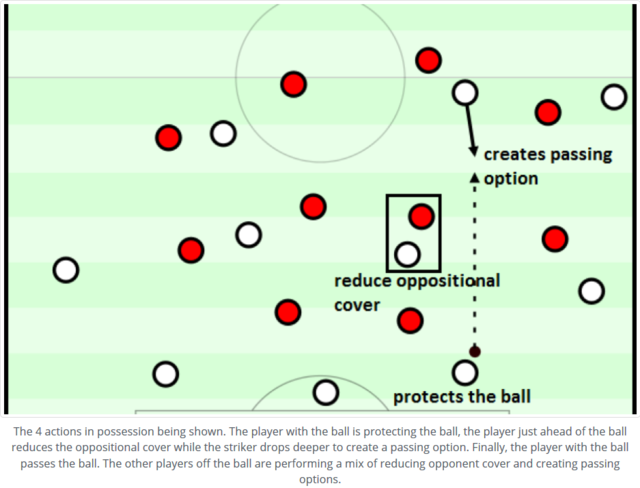
ポゼッションにおける4つのアクションが示されている。ボールを持っているプレイヤーがボールを守り、ボールのすぐ前にいるプレイヤーが相手のカバーを減らし、ストライカーが深く下がってパスの選択肢を作る。最後に、ボールを持ったプレイヤーがボールをパスする。ボールを持っていない他のプレイヤーは、相手のカバーを減らしてパスの選択肢を作っている。
This simple premise, combined with a trend of teams defending better and better over the years, made the counterattack and transition play, in general, become even more important than it was before. Ralf Rangnick spoke on this topic in his piece on The Coaches’ Voice:
“Sometimes, teams park two buses in front of their box and force us to have lots of possession, which makes it more difficult to pick up pace and create clear goalscoring opportunities. If you have too much possession, your game resembles handball and you don’t get anywhere.
We are prepared to play risky passes, at the danger of them going
astray, because that opens up the
possibility to attack the second ball.
The
most exciting thing for me is to see how the transition game has developed and accelerated. There’s so much happening in the eight to 10 seconds after the ball is won or lost. Those moments decide games, and a large part of our training is dedicated to what we call swarming behaviour; the synchronised movement of players.“
この単純な前提が、長年にわたってより良い守備をするチームの傾向と相まって、反撃とトランジションプレー全般が、以前よりもさらに重要になっている。ラルフ・ラングニック氏は、『The Coaches' Voice』に掲載された作品の中で、この話題について語っている。
"時として、チームは自分たちのボックスの前にバスを2台停めて、たくさんのポゼッションを持つことを強要し、その結果、ペースを拾って明確なゴールチャンスを作ることが難しくなってしまう。ポゼッションが多すぎると、ゲームがハンドボールに似てしまい、どこにも行けなくなってしまう。
セカンドボールを攻撃する可能性が広がるので、パスが逸れてしまう危険を冒してでもリスクのあるプレーをする準備をしています。
私にとって最もエキサイティングなのは、トランジションゲームがどのように発展し、加速しているかを見ることだ。ボールを獲得した後の8~10秒の間には、多くのことが起こっています。私たちのトレーニングの大部分は、私たちが「群行動」と呼んでいるもの、つまり選手の動きを同期させることに専念しています。
As it naturally happens with such trends, they define the next development: The organization in possession was not only developed to attack better, but also to defend better. Not only the decision-making regarding offering a passing option and passing changed but also the approach of coaches. Concepts like rest-defense evolved with differing rules.
First, the immediate prevention of a counter by counter-pressing emerged, coming naturally from the staggering when losing the possession of the ball and the risk a counter would give. Even tactical fouling or a changed attacking play in general (long balls under pressure or using higher risk in higher zones on purpose) could be factored into this category of prevention of the counter and an immediate shutdown of the transition. Its offensive purposes are very clear: There would be no need to change from attacking to defending while luring the opponents to do the opposite, ideally catching them on the wrong foot and being able to again attack from a (less clean) attacking organization with the opponent caught between two intentions and, thus, organizations.
Yet, teams would find a way out of these. In order to escape the press, rules of counter-press were mirrored and solutions created to solve these problems: Play the first pass out of pressure, ideally deep or diagonally, etc. “Rest-defense” as a concept stems from preventing these outlet passes going through the initial counter-press; “Rest-offense” or “rest-attack” is now another answer to this trend. By utilizing similar principles as in attacking play against a team having fewer players and organization behind the ball, there is the
possibility of utilizing the typical advantages of the counter again, even when facing a better-prepared opposition – the combination with the prior defensive play and organization is the key in this regard.
Mostly players “gambling” for the counter would only be involved by covering a very small part of the pitch, preventing passes only near them and preparing for the transition that would (hopefully) ensue sooner than later. The next development – mainly utilized by Liverpool, but partly by other teams before – is a different involvement of the players positioned for the counter-attack; more activity when trying to win the ball or prevent specific passes, tied into the general strategy of the team for not only defending the oppositional attacks but also creating their own counters within their own attacking priorities.
このような傾向には当然のことながら、彼らは次の展開を定義します。所持している組織は、より良い攻撃をするだけでなく、より良い防御をするために開発されました。だけでなく、オプションを渡すことを提供することについての意思決定が変更されただけでなく、コーチのアプローチ。レストディフェンスのような概念は、異なるルールで進化しました。
まず、ボールを失ったときのよろめきとカウンターのリスクから、カウンタープレスによるカウンターの即時防止が自然に生まれた。戦術的なファウルや攻撃プレー全般の変化(プレッシャーの下でのロングボールや、わざと高いゾーンでリスクの高いプレーを使うこと)でさえも、カウンターの防止とトランジションの即時停止というこのカテゴリーに織り込むことができたのである。その攻撃的な目的は非常に明確である。攻撃から守備へと変化させる必要はなく、理想的には相手に逆のことをさせることで相手の足元を捉え、相手が2つの意図と組織の間に挟まれた状態で(あまりクリーンではない)攻撃的な組織から再び攻撃することができるようになる。
それでも、チームはこれらから抜け出す方法を見つけるだろう。プレスから逃れるために、カウンタープレスのルールをミラーリングし、これらの問題を解決するためのソリューションを作成しました。プレッシャーからの最初のパスを、理想的には深く、または斜めにプレーするなど。"概念としての「レストディフェンス」は,最初のカウンタープレスを通過するアウトレットパスを防ぐことに由来している.ボールを持っている選手や組織が少ないチームの攻撃プレーと同様の原理を利用することで、準備の整った相手であっても、カウンターの典型的な利点を再び生かすことができる可能性があり、事前のディフェンスプレーや組織との組み合わせが鍵となる。
ほとんどの選手がカウンターのために「ギャンブル」をするのは、ピッチのごく一部をカバーし、自分たちの近くでパスを防ぐだけで、(うまくいけば)すぐに続くであろう移行の準備をすることによってのみである。次の展開は、主にリバプールによって利用されているが、以前は他のチームによって部分的に利用されていたが、カウンター攻撃のために配置された選手の別の関与である。
Anything Else?
他には?
In the end, there is still more room to grow and evolve, and still more variations of counterattacks possible than the 3 general approaches to positioning and the 7 common patterns described in this article. On that note, it is important to remember that some of the details that were discovered through the 2010s from positional play can also be applied to the other phases of the game.
Jurgen Klopp’s Liverpool has brought football to another level over the last two years. Not only in
tactics and strategy through the phases of the game, but also through recruitment and scouting of players, man-management, and analytics. It will be interesting to see how football continues to evolve as analysis becomes increasingly important in the sport.
結局のところ、ポジショニングの3つの一般的なアプローチやこの記事で紹介した7つの共通パターンよりも、まだまだ成長と進化の余地があり、反撃のバリエーションも増えています。その点、2010年代を通じてポジショニングプレーから発見された詳細のいくつかは、ゲームの他のフェーズにも適用できることを覚えておくことが重要である。
ユルゲン・クロップのリバプールは、この2年間でサッカーを別のレベルに引き上げた。ゲームの各局面における戦術や戦略だけでなく、選手のリクルートやスカウティング、マンマネジメント、アナリティクスなども含めて。分析の重要性が増していく中で、サッカーがどのように進化していくのか、興味深いところだ。













